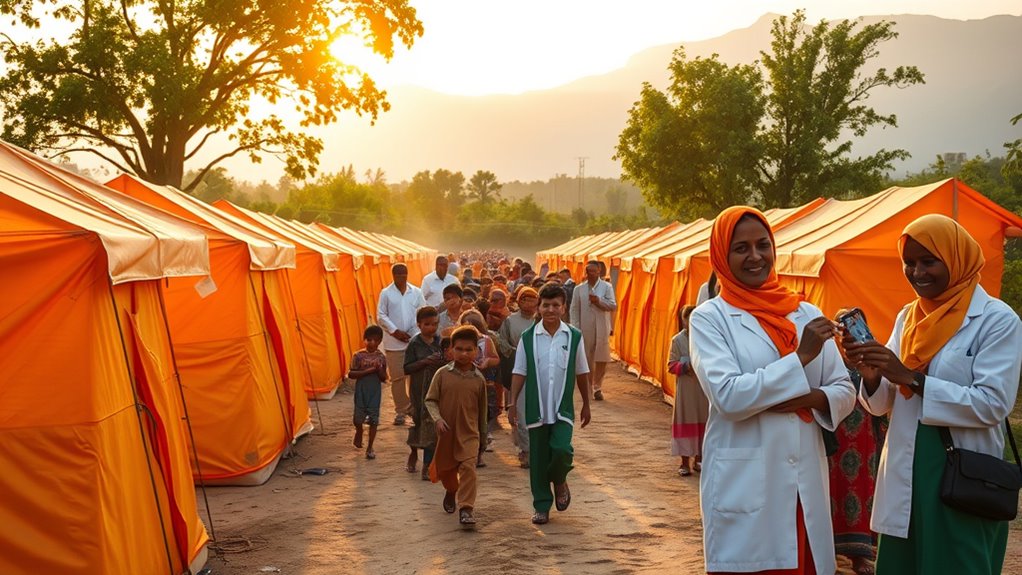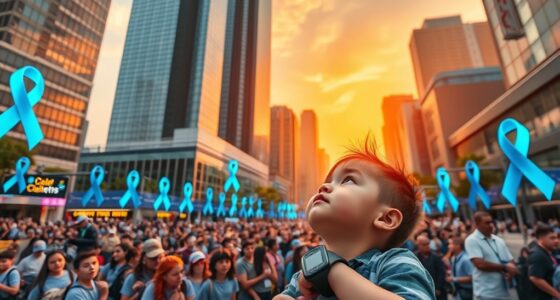Efforts to eradicate polio by 2025 involve extensive vaccination campaigns, improved logistics, and strong community engagement. You’ll see vaccine teams reaching every child, even in hard-to-access areas, with cold chain systems ensuring vaccines stay effective. Trust-building with local leaders and residents boosts participation. As these strategies continue to evolve, you’ll discover how coordinated worldwide efforts are transforming the fight against this disease for good. Keep exploring to learn how close we are to ending polio forever.
Key Takeaways
- Global efforts focus on vaccinating every child and strengthening logistics to eliminate polio by 2025.
- Community engagement and trust-building are crucial to overcoming resistance and ensuring widespread vaccine acceptance.
- Addressing logistical challenges, such as cold chain maintenance and access issues, is vital for effective vaccination campaigns.
- Tailored outreach strategies and local partnerships help reach hard-to-access populations in remote regions.
- Sustainable practices and collaboration are essential to achieve and maintain a polio-free world by 2025.

Have you ever wondered how the world is working to eliminate polio? It’s a massive effort that involves careful vaccine distribution and strong community engagement. Vaccines are at the heart of this mission, but simply having enough doses isn’t enough. You need to get those vaccines to the right places, especially in remote or underserved communities. This requires meticulous planning, logistics, and coordination among governments, health organizations, and local leaders. The goal is to reach every child, no matter where they live, and ensure they’re protected against the disease. This is where vaccine distribution becomes a critical component. It’s not just about delivering vaccines; it’s about making sure they’re stored properly, transported efficiently, and administered safely. Cold chain logistics, for example, are essential to keep vaccines effective, especially in regions with limited infrastructure. You’ll see mobile clinics, outreach campaigns, and immunization days designed to maximize coverage. But even the best vaccine supply won’t succeed without community engagement. People need to trust the health workers and understand the importance of vaccination. That’s why local leaders, religious figures, and community members are involved in spreading awareness and dispelling myths about the vaccine. When communities are actively engaged, they become partners in the eradication effort rather than passive recipients. This trust-building is crucial to overcome resistance and misinformation, which can hinder vaccination campaigns. You might notice that health teams often work closely with local influencers to tailor messages that resonate culturally and linguistically. These efforts create a sense of ownership among community members, making vaccination campaigns more successful. By involving communities early and consistently, health workers can better identify and address concerns, leading to higher uptake. Additionally, community engagement helps identify logistical challenges and barriers to access, allowing for tailored solutions. For example, if transportation is an issue, local volunteers might help establish temporary vaccination points. When vaccine distribution is combined with active community participation, the campaigns become more effective and sustainable. This integrated approach ensures that no child is left behind and that the goal of a polio-free world becomes achievable. As we push toward 2025, these strategies are more crucial than ever. They remind us that eradicating polio isn’t just about vaccines; it’s about building trust, fostering cooperation, and making sure every child is reached. Furthermore, adopting sustainable practices in vaccine logistics can significantly improve the efficiency and resilience of immunization campaigns. In the end, it’s this collaboration that will tip the scales and finally eliminate polio from our world.
Frequently Asked Questions
What Are the Main Challenges to Polio Eradication?
You face challenges like vaccine hesitancy, where some communities distrust immunization efforts, and political instability, which hampers health campaigns. These issues slow down vaccination coverage, making it harder to eliminate polio entirely. You also need to tackle logistical hurdles and misinformation that undermine trust. Overcoming these obstacles requires consistent education, community engagement, and stable governance to guarantee every child receives the vaccine and push toward eradication succeeds.
How Do Vaccine-Resistant Strains Affect Eradication Efforts?
Vaccine-resistant strains substantially threaten your eradication efforts. When a strain mutates, it can escape vaccine protection, creating a dangerous gap in immunity. This vaccine escape means that even vaccinated populations might still contract and spread the virus, complicating containment. You must stay vigilant, adapt strategies, and develop new vaccines to counter these evolving strains. Without this, the goal of complete eradication remains just out of reach, lurking as a persistent threat.
What Role Do Local Communities Play in Vaccination Campaigns?
You play a vital role in vaccination campaigns by fostering community engagement. Your efforts help overcome cultural barriers that might prevent people from getting vaccinated. When you work with local communities, you build trust, dispel misinformation, and encourage participation. This engagement guarantees more people accept vaccines, making eradication efforts more effective. Your involvement directly impacts the success of the campaign, helping to protect everyone from polio and ultimately eradicate the disease.
Are There New Technologies Aiding in Polio Detection?
Yes, new technologies are helping you detect polio more effectively. Molecular diagnostics allow you to identify the virus quickly and accurately from blood or stool samples. Environmental surveillance enables you to monitor sewage systems for traces of the virus, providing early warning signs in communities. These tools improve your ability to target vaccination efforts, prevent outbreaks, and ultimately help eradicate polio by 2025.
How Is Funding for Eradication Efforts Sustained Globally?
Funding for eradication efforts stays strong through strategic donor engagement and diverse funding models. You can see organizations rallying resources via partnerships, public-private collaborations, and innovative financing. Donors stay committed because of transparent tracking and targeted goals. This sustained support, combined with flexible funding streams, keeps the fight against polio progressing. By leveraging these methods, eradication efforts remain resilient, ensuring resources are readily available to reach every corner and ultimately eradicate polio worldwide.
Conclusion
If you stay committed, if you keep pushing, if you refuse to give up, then we can finally see a world free of polio. Together, we can break the cycle, end the transmission, and wipe out this disease once and for all. Your support, your action, your hope are what will turn the tide. Because in this fight, persistence is power, and victory is within reach if we all stand united.









